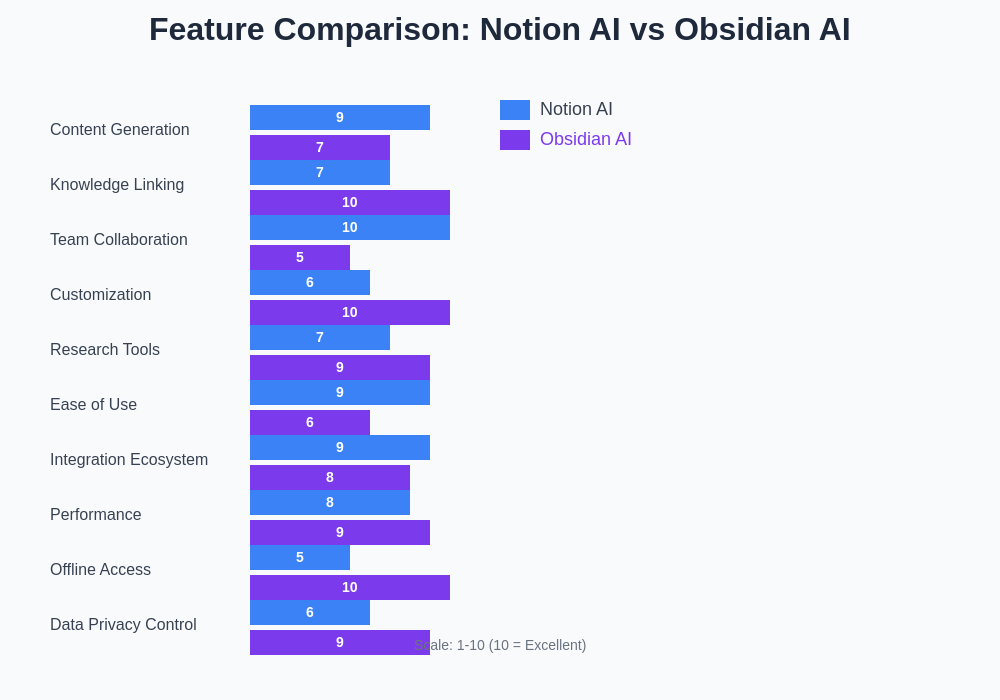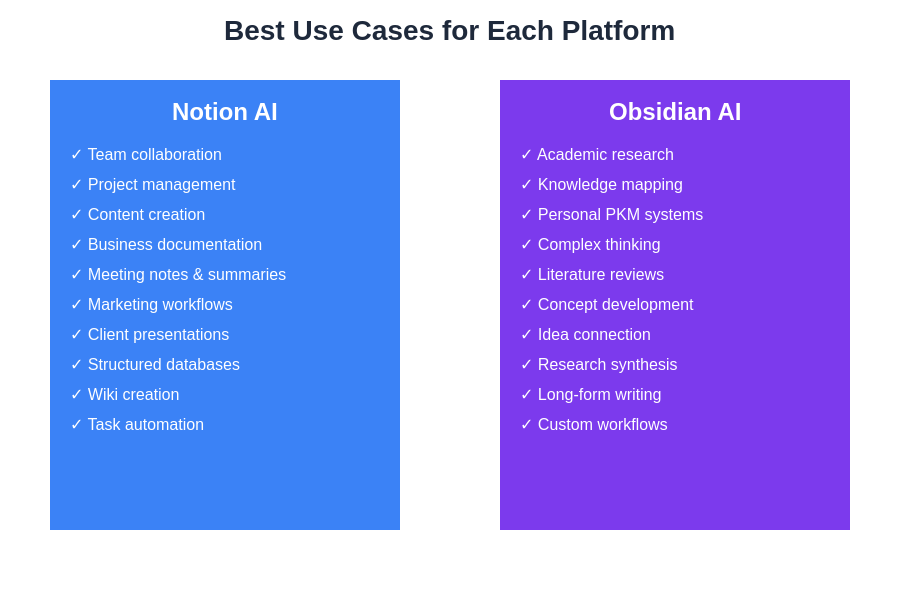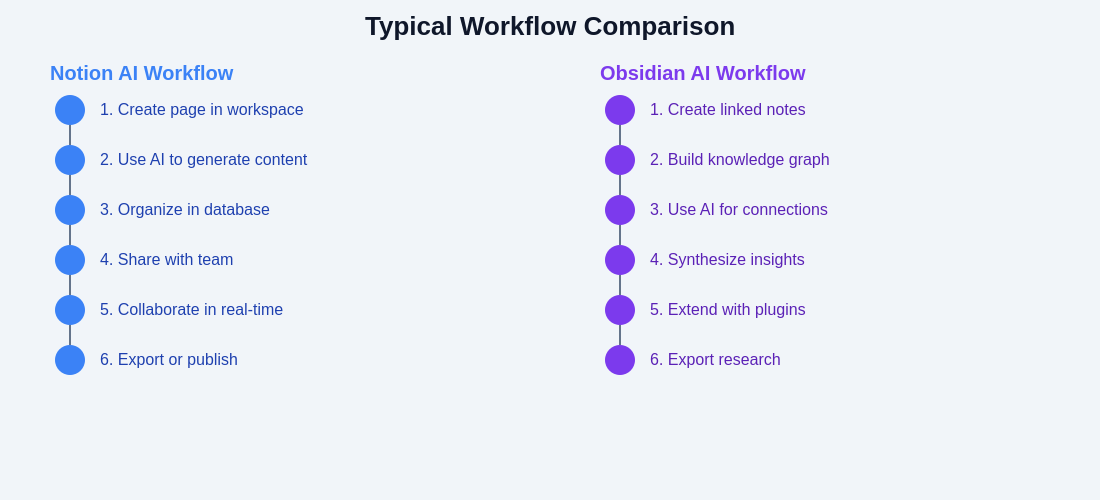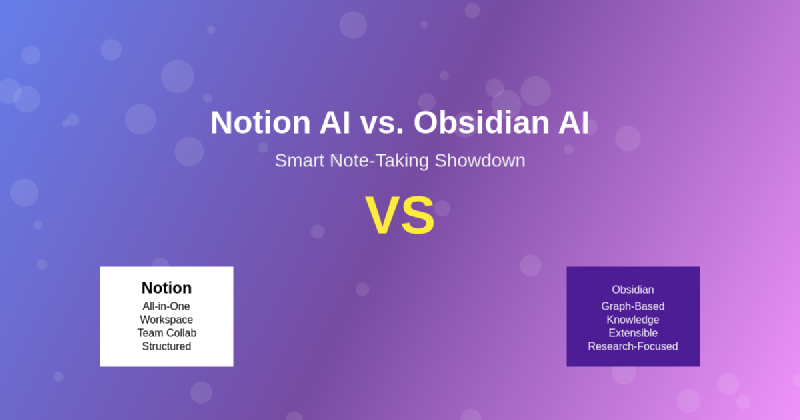The digital note-taking landscape has been revolutionized by artificial intelligence, transforming simple text editors into intelligent knowledge companions that can write, analyze, summarize, and connect ideas in ways previously unimaginable. Two platforms have emerged as frontrunners in this AI-powered productivity revolution: Notion AI and Obsidian AI, each offering unique approaches to intelligent note-taking that cater to different user preferences and workflow requirements.
Explore the latest AI productivity trends to discover cutting-edge tools and techniques that are reshaping how we capture, organize, and leverage knowledge in our personal and professional lives. The competition between these two platforms represents more than just a feature comparison; it embodies fundamentally different philosophies about how artificial intelligence should augment human thinking and knowledge management processes.
Understanding the Platforms: Architecture and Philosophy
Notion AI represents an integrated approach to intelligent productivity, embedding artificial intelligence directly into a comprehensive workspace that combines databases, wikis, project management, and collaborative features within a single unified platform. The AI functionality serves as a natural extension of Notion’s all-in-one philosophy, providing writing assistance, content generation, and data analysis capabilities that seamlessly integrate with existing workflows and organizational structures.
Obsidian AI takes a different approach, focusing on enhancing the powerful graph-based knowledge management system that has made Obsidian popular among researchers, academics, and knowledge workers who prioritize deep thinking and idea connection. The AI features in Obsidian are designed to complement the platform’s core strength in creating interconnected networks of knowledge while maintaining the flexibility and extensibility that users expect from the Obsidian ecosystem.
The fundamental difference between these approaches reflects broader questions about how AI should integrate with human knowledge work. Notion AI emphasizes convenience and accessibility, making advanced AI capabilities available through intuitive interfaces that require minimal learning curve. Obsidian AI prioritizes depth and customization, offering powerful AI tools that can be configured and extended to match sophisticated knowledge management workflows.
Content Generation and Writing Assistance
Both platforms excel in AI-powered content generation, but their implementations reveal distinct strengths that appeal to different types of users and use cases. Notion AI provides comprehensive writing assistance that feels natural and intuitive, offering features such as automated blog post creation, meeting note summarization, and creative writing prompts that integrate seamlessly with the platform’s block-based editing system. The AI can generate content in multiple formats, from simple bullet points to complex structured documents, while maintaining consistency with existing content and organizational standards.
Enhance your writing workflow with Claude AI for advanced reasoning and nuanced content generation that complements your note-taking platform of choice. The synergy between dedicated writing AI and specialized note-taking tools creates powerful workflows for content creation and knowledge synthesis.
Obsidian AI approaches content generation with a focus on enhancing the thinking process rather than replacing it. The AI features are designed to help users develop ideas, explore connections between concepts, and generate insights based on existing knowledge graphs. This approach makes Obsidian AI particularly powerful for research-intensive work, academic writing, and complex project development where the AI serves as a thinking partner rather than a simple content generator.
The quality of generated content differs between the platforms in ways that reflect their target audiences. Notion AI excels at producing polished, publication-ready content that requires minimal editing and fits well within collaborative environments where multiple team members need to contribute to and review AI-generated material. Obsidian AI generates content that serves as a starting point for further development, providing rich conceptual foundations that users can expand upon through their own expertise and research.
Knowledge Organization and Connection Discovery
The approach to knowledge organization represents perhaps the most significant difference between Notion AI and Obsidian AI, with each platform leveraging AI to enhance their respective organizational philosophies in unique ways. Notion AI utilizes artificial intelligence to enhance the platform’s database-driven approach to information management, providing intelligent tagging, automatic categorization, and smart filtering capabilities that help users maintain organized workspaces even as content volume grows substantially.
The AI in Notion can analyze content patterns, suggest optimal database structures, and automatically populate properties based on content analysis, making it easier to maintain consistency across large collaborative workspaces. This systematic approach to organization works particularly well for teams and individuals who prefer structured, hierarchical information architecture where everything has its designated place within a clearly defined system.
Obsidian AI takes advantage of the platform’s graph-based knowledge representation to provide intelligent connection discovery and relationship mapping that goes beyond simple keyword matching. The AI can identify conceptual relationships between notes, suggest relevant connections based on content similarity, and help users discover unexpected insights by highlighting patterns within their knowledge graph that might not be immediately apparent through manual review.
This difference in organizational approach has profound implications for how users interact with their accumulated knowledge over time. Notion AI helps users maintain clean, well-organized information repositories that facilitate easy retrieval and team collaboration. Obsidian AI helps users develop deep understanding through serendipitous discovery and connection-making that can lead to creative insights and innovative thinking.

The comprehensive feature comparison reveals distinct strengths and trade-offs between both platforms. While Notion AI excels in collaborative features, ease of use, and content generation, Obsidian AI demonstrates superior capabilities in knowledge linking, customization options, and offline functionality. These differences reflect their fundamental design philosophies and target user bases.
Research and Analysis Capabilities
Both platforms offer sophisticated research and analysis capabilities, but their implementations reflect different assumptions about how users conduct research and synthesize information. Notion AI provides comprehensive research assistance that integrates well with project management workflows, offering capabilities such as automatic source citation, content summarization, and research topic generation that support structured research processes from initial planning through final presentation.
The platform’s AI can analyze multiple sources simultaneously, identify key themes and findings, and generate comprehensive research summaries that maintain appropriate academic or professional formatting standards. This makes Notion AI particularly valuable for business research, content marketing, and collaborative research projects where multiple team members need to contribute to and build upon shared research foundations.
Leverage Perplexity AI for comprehensive research to gather information that can then be processed and organized through your preferred note-taking platform’s AI capabilities. The combination of specialized research tools with intelligent note-taking creates powerful workflows for knowledge synthesis and analysis.
Obsidian AI excels in deep analytical work that requires connecting insights across multiple documents and time periods. The AI can trace the evolution of ideas through your knowledge graph, identify contradictions or gaps in your thinking, and suggest areas where additional research might be valuable. This capability makes Obsidian AI particularly powerful for academic research, long-term project development, and any work that requires building complex arguments or theoretical frameworks over extended periods.
The analytical outputs from each platform serve different purposes in the research workflow. Notion AI generates analysis that is immediately actionable and presentation-ready, suitable for reports, presentations, and collaborative decision-making processes. Obsidian AI generates analysis that deepens understanding and reveals new research directions, supporting the iterative process of knowledge development that characterizes high-quality intellectual work.
Collaboration and Sharing Features
The collaborative capabilities of these platforms reflect their different target audiences and use cases, with each offering AI-enhanced collaboration features that align with their overall platform philosophies. Notion AI excels in team-based collaboration, providing AI features that facilitate smooth information sharing, consistent formatting, and collaborative content creation across multiple users and permission levels.
The platform’s AI can standardize content across team members, suggest improvements to shared documents, and automatically generate meeting summaries and action items that integrate with project management workflows. These features make Notion AI particularly valuable for distributed teams, content creation workflows, and any situation where multiple people need to contribute to and maintain shared knowledge repositories.
Obsidian AI approaches collaboration from the perspective of knowledge sharing rather than real-time collaborative editing. The platform’s AI features help users prepare their knowledge for sharing by generating explanations, creating concept maps, and identifying the most relevant information for specific audiences. This approach works well for academic collaboration, consulting work, and situations where expert knowledge needs to be packaged and transmitted to others.
The difference in collaborative approaches has significant implications for team adoption and workflow integration. Notion AI provides immediate value for teams that need to collaborate on documents and projects in real-time, offering AI assistance that enhances existing collaborative practices. Obsidian AI provides value for knowledge workers who need to share expertise and insights, offering AI tools that help translate personal knowledge systems into formats that others can understand and build upon.
Customization and Extensibility
The extensibility of AI features represents another area where these platforms diverge significantly, reflecting different philosophies about user agency and system flexibility. Notion AI operates within a more constrained but polished environment where AI features are carefully integrated into the platform’s existing functionality, providing consistent experiences that work reliably across different use cases without requiring extensive configuration or technical expertise.
This approach makes Notion AI immediately accessible to users who want powerful AI capabilities without needing to understand the technical details of how those capabilities are implemented. The trade-off is reduced flexibility in customizing AI behavior to match specific workflow requirements or integrating with external tools and systems that might be important for particular use cases.
Obsidian AI embraces the platform’s plugin ecosystem and extensibility philosophy, offering AI features that can be extensively customized, extended, and integrated with other tools through the platform’s robust plugin architecture. Users can modify AI behavior, create custom workflows, and integrate external AI services to create highly personalized knowledge management systems that match their specific requirements and preferences.
This flexibility comes with increased complexity and a steeper learning curve, but it enables power users to create sophisticated AI-enhanced workflows that would be impossible within more constrained systems. The ability to customize AI features makes Obsidian particularly attractive to users with technical expertise who want to create optimized workflows for specific domains or use cases.
Performance and Reliability Considerations
The performance characteristics of AI features in both platforms reflect their underlying architectures and design priorities, with implications for user experience and workflow reliability. Notion AI benefits from integration with cloud-based infrastructure that provides consistent performance and regular updates, but this dependency on external services means that AI functionality may be affected by network connectivity issues or service outages beyond user control.
The cloud-based approach also enables Notion to continuously improve AI capabilities and roll out new features without requiring user intervention, ensuring that all users have access to the latest AI developments. However, this model raises considerations about data privacy and control that may be important for users working with sensitive information or operating in regulated environments.
Obsidian AI operates within the platform’s hybrid architecture that combines local processing with cloud services, providing users with more control over their data and AI processing while potentially offering better performance for certain types of operations. The local processing capabilities mean that some AI features can continue working even without internet connectivity, which can be important for users who work in environments with unreliable network access.
Integration Ecosystem and Workflow Compatibility
Both platforms offer different approaches to integrating AI capabilities with existing productivity ecosystems, reflecting their broader philosophies about how knowledge management tools should fit within larger workflow systems. Notion AI leverages the platform’s extensive integration library to provide AI-enhanced workflows that connect with popular productivity tools, project management systems, and communication platforms.
These integrations enable AI features to work across application boundaries, automatically generating content for external systems, analyzing data from multiple sources, and maintaining consistency across different tools and platforms. This comprehensive integration approach makes Notion AI particularly valuable for users who work within established productivity ecosystems and need AI capabilities that enhance existing workflows rather than replacing them.
Obsidian AI focuses on deep integration with knowledge work tools and research platforms, offering connections with reference managers, academic databases, and specialized analysis tools that support research-intensive workflows. The platform’s plugin architecture enables users to create custom integrations that match their specific workflow requirements, though this often requires more technical expertise than the pre-built integrations offered by Notion.
Pricing and Accessibility Models
The economic models for accessing AI features differ between the platforms in ways that reflect their target markets and development strategies. Notion AI operates on a subscription model that provides predictable access to AI features as part of the broader platform subscription, making it easy for teams and organizations to budget for AI-enhanced productivity tools as part of their operational expenses.
This model provides good value for teams that use Notion’s full feature set and want AI capabilities integrated throughout their workflows. However, users who primarily want AI features without needing Notion’s comprehensive workspace functionality may find the pricing less attractive compared to specialized AI tools.
Obsidian AI operates within the platform’s freemium model, where basic AI features may be available through community plugins while advanced capabilities require paid subscriptions or plugin purchases. This approach provides more flexibility for users who want to experiment with AI features before committing to ongoing expenses, but it can result in a more complex and potentially more expensive path to accessing comprehensive AI capabilities.
Future Development and Innovation Trajectories
The future development paths for these platforms suggest continued divergence in their approaches to AI integration, with implications for long-term user adoption and ecosystem development. Notion AI appears focused on expanding the breadth of AI applications within the platform’s workspace environment, developing features that enhance team collaboration, automate routine tasks, and provide intelligent insights across different types of content and workflows.
This trajectory suggests that Notion AI will continue to excel in team-based productivity scenarios where AI serves as a force multiplier for collaborative work. The platform’s investment in AI infrastructure and user experience design positions it well for mainstream adoption among knowledge workers who want sophisticated AI capabilities without technical complexity.
Obsidian AI seems committed to deepening the platform’s capabilities for individual knowledge work and specialized applications, developing AI features that enhance the platform’s core strengths in connection discovery, knowledge synthesis, and intellectual development. This approach suggests continued innovation in areas such as research assistance, academic writing support, and specialized domain applications.
The different trajectories reflect the platforms’ understanding of their competitive advantages and target markets. Notion AI leverages the platform’s strength in team collaboration and structured workflows to create AI experiences that enhance group productivity. Obsidian AI builds on the platform’s foundation in graph-based knowledge management to create AI tools that support deep thinking and specialized knowledge work.

Understanding the optimal use cases for each platform helps users make informed decisions based on their specific workflow requirements and collaboration needs. The visual comparison illustrates how different professional contexts and personal productivity styles align with each platform’s strengths.
Making the Choice: Platform Selection Guidelines
Choosing between Notion AI and Obsidian AI requires careful consideration of workflow requirements, team dynamics, and long-term productivity goals. Notion AI represents the better choice for users and teams who prioritize ease of use, comprehensive collaboration features, and integration with structured productivity workflows. The platform excels in scenarios where multiple people need to create, edit, and maintain shared knowledge repositories while leveraging AI assistance to enhance productivity and maintain consistency.
Teams working on content creation, project management, and business development will likely find Notion AI’s combination of structured organization and intelligent assistance particularly valuable. The platform’s strength in generating polished, presentation-ready content makes it ideal for environments where AI-generated material needs to be immediately usable for external communication and collaboration.
Obsidian AI better serves users who prioritize depth over breadth, customization over convenience, and individual knowledge development over team collaboration. Researchers, academics, consultants, and knowledge workers who need to develop complex understanding over time will appreciate the platform’s focus on connection discovery and analytical depth.
The platform’s extensibility makes it particularly attractive to users with technical expertise who want to create highly optimized workflows for specialized applications. The ability to customize AI behavior and integrate with specialized tools creates opportunities for sophisticated knowledge management systems that would be difficult to replicate in more constrained environments.
Both platforms continue to evolve rapidly, with regular updates and feature additions that expand their capabilities and address user feedback. The choice between them may ultimately depend on whether you prioritize the comprehensive, integrated experience offered by Notion AI or the flexible, customizable approach provided by Obsidian AI. Understanding your specific workflow requirements, collaboration needs, and technical comfort level will guide you toward the platform that best supports your knowledge management and productivity goals.

The typical workflow comparison demonstrates how each platform approaches the knowledge management process differently. Notion AI emphasizes structured collaboration and publication-ready outputs, while Obsidian AI focuses on knowledge synthesis and research-driven insights through interconnected thinking patterns.
Disclaimer
This article is for informational purposes only and does not constitute professional advice. The comparison is based on publicly available information about both platforms’ AI capabilities as of the publication date. Features and pricing may change over time, and readers should conduct their own evaluation based on their specific requirements. The effectiveness of AI features may vary depending on individual use cases, content types, and workflow complexity. Both platforms offer trial periods or free tiers that allow users to evaluate their suitability before making long-term commitments.
